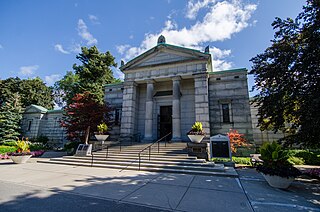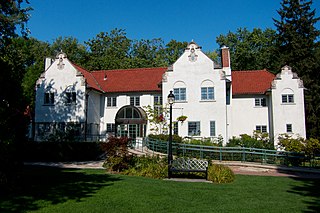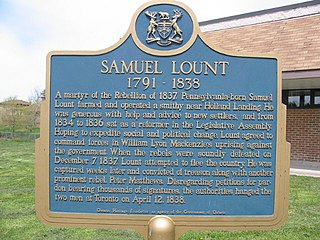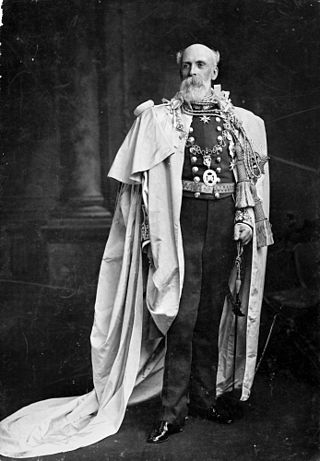Related Research Articles

Mount Pleasant Cemetery is a cemetery located in Toronto, Ontario, Canada, and is part of the Mount Pleasant Group of Cemeteries. It was opened in November 1876 and is located north of Moore Park, a neighbourhood of Toronto. The cemetery has kilometres of drives and walking paths interspersed with fountains, statues and botanical gardens, as well as rare and distinct trees. It was originally laid out by German-born landscape architect Henry Adolph Engelhardt, inspired by the European and American garden cemeteries of the 19th century, and with influences from Mount Auburn Cemetery in Boston.

Sir William Mulock was a Canadian lawyer, businessman, educator, farmer, politician, judge, and philanthropist. He served as vice-chancellor of the University of Toronto from 1881 to 1900, negotiating the federation of denominational colleges and professional schools into a modern university.

Brigadier-General Sir John Johnson, 2nd Baronet was an American-born military officer, politician and landowner who fought as a Loyalist during the American Revolutionary War. He was the son of Sir William Johnson, 1st Baronet, a prominent British Indian Department official in the Thirteen Colonies. Johnson inherited his father's baronetcy and estate in 1774.

The Cawthra family of Toronto was famous for its business, social and cultural contributions to the city. It is one of the oldest families in Toronto, and many descendants of the family's founder, Joseph Cawthra, continue to play significant roles in Toronto society.
Joseph Cawthra was a Canadian merchant and politician. Cawthra arrived in York, Upper Canada, from Yeadon, Yorkshire, England, in 1802. He was granted a 400 acres (162 ha) tract of land in Mississauga, Ontario by the Crown, provided he built a home on it within four years. The land remained in the hands of the Cawthra Family up until the 1970s, and much of it is now retained by the City of Mississauga as parkland.
William Cawthra was a philanthropist, business and civic leader and the eldest son of Joseph Cawthra. William, like his father, was associated with reformists and was considered anti-establishment, notwithstanding his wealth. William was elected to Toronto City Council as the Alderman for St. Lawrence Ward in 1836, a position his father held for one year until he was unseated in 1835 by conservative opposition.
Anthony Patrick Cawthra Adamson was a Canadian architect, author, teacher, and municipal politician. He was a descendant of Joseph Cawthra through his mother.

John R. Williams was an American soldier, merchant, and politician who is best known for serving as the first mayor of Detroit, Michigan, after the city's reincorporation. In total, he served as Detroit's mayor for five other terms. He also was a brigadier general in the United States Army during the Black Hawk War.

Sir John Beverley Robinson, 1st Baronet, was a lawyer, judge and political figure in Upper Canada. He was considered the leader of the Family Compact, a group of families which effectively controlled the early government of Upper Canada.

Samuel Lount was a blacksmith, farmer, magistrate and member of the Legislative Assembly in the province of Upper Canada for Simcoe County from 1834 to 1836. He was an organizer of the failed Upper Canada Rebellion of 1837, for which he was hanged as a traitor. His execution made him a martyr to the Upper Canadian Reform movement.

The Adamson Estate, which forms the eastern boundary of the Port Credit neighbourhood of Mississauga, Ontario, was purchased from the family of Agar Adamson by Credit Valley Conservation Authority in 1975 upon the urging of the local ratepayers group known as Project H21 after a proposed real estate development which would have changed the character of the neighbourhood. It is now a public park on the Waterfront Trail. It was recognized as a Historic Place in 1978.

William Botsford Jarvis was an important member of the Family Compact and Sheriff of the Home District. His estate in what was then York, Upper Canada, gave its name to Rosedale, Toronto. Jarvis Street was named for his cousin, Samuel.

Joseph Renville (1779–1846) was an interpreter, translator, expedition guide, Canadian officer in the War of 1812, founder of the Columbia Fur Company, and an important figure in dealings between settlers of European ancestry and Dakota (Sioux) Natives in Minnesota. He contributed to the translation of Christian religious texts into the Dakota language. The hymnal Dakota dowanpi kin, was "composed by J. Renville and sons, and the missionaries of the A.B.C.F.M." and was published in Boston in 1842. Its successor, Dakota Odowan, first published with music in 1879, has been reprinted many times and is in use today.

Wentworth Cheswell was an American assessor, auditor, Justice of the Peace, teacher and Revolutionary War veteran in Newmarket, New Hampshire. Elected as town constable in 1768, he was elected to other positions, serving in local government every year but one until his death.

Reginald Brabazon, 12th Earl of Meath was an Irish politician and philanthropist.
Joseph Hermon Cawthra (1886–1971), was an English monumental sculptor. During his lifetime he was considered among the leading classical sculptors working in Britain and received several commissions for public monuments, war memorials and architectural sculptures.

Joseph Sheard was an English architect and politician. He was Mayor of Toronto from 1871 to 1872.

Mabel Cawthra Adamson (1871–1943) was a Canadian painter and decorator, who was active in the Arts and Crafts movement in Toronto.

Agar Stewart Allan Masterton Adamson was a Canadian soldier who married the Toronto heiress Mabel Cawthra. He served with distinction in the Second Boer War and in World War I, and commanded the Princess Patricia's Canadian Light Infantry from 1916 to 1918. He died after an airplane crash in the Irish Sea.
Cawthra House is the name of two of three homes associated with the Cawthra family in the Greater Toronto Area.
References
- 1 2 3 4 5 Johnson, JK (1989). Becoming Prominent: Regional Leadership in Upper Canada, 1791-1841. McGill-Queen's Press - MQUP. p. 181. ISBN 0-7735-0641-1 . Retrieved 2012-04-07.
- 1 2 3 "Joseph Cawthra". The Canadian biographical dictionary and portrait gallery of eminent and self-made men. 1880. p. 205. Retrieved 2012-04-07.
- ↑ "Heritage sidewalk markers, Town of Newmarket". Town of Newmarket. Archived from the original on 2012-09-04. Retrieved 2012-04-07.
- ↑ Gemmill, JA (1883). The Canadian parliamentary companion, 1883. p. 143. Retrieved 2012-04-07.